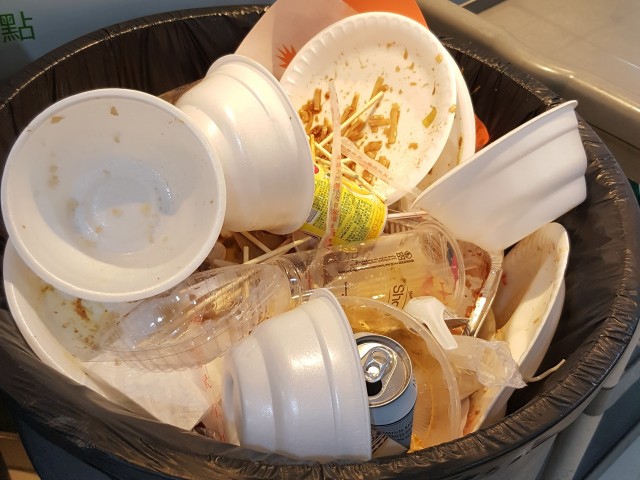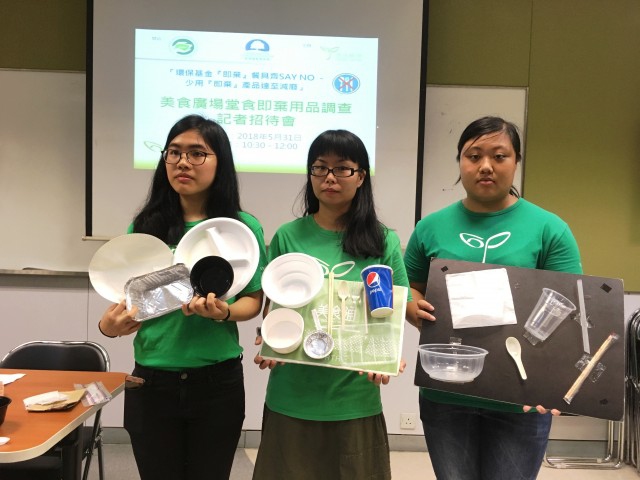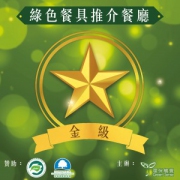Green Sense survey of dine-in disposable utensils in HK food courts
Tai Hing Restaurant abusively delivering 11 disposables per meal
Food-fest in Festival Walk is the most wasteful Food Court“Waste reduction at source
Change the habit of using ‘disposables’”
Green Sense has been concerned with the use of disposable utensils in Hong Kong for many years and has been encouraging “Less Use” of disposable products in the society. This survey is one of the major parts of the project “ECF SAY NO to ‘Disposables’ – Less Disposables to Reduce Waste”, funded by Environment and Conservation Fund (ECF) and Environmental Campaign Committee (ECC).
Most of the food courts in Hong Kong are delivering disposable tableware for dine-in meal abusively, we then carried out a survey investigating 10 food courts totalling 106 restaurants at lunchtime. After counting over 4000 meals, rating are given to the food courts according to our “Green Utensils Star Programme”. Since the wastage is closely related to the upcoming “Municipal Waste Charging’, we should consider the problem of disposables in the environmental and financial aspects.
Background
The quantity of disposal waste in Hong Kong is enormous, landfills have nearly saturated. In 2016, each Hong Kong citizen produced 1.41 kg municipal solid waste per day. Plastic was the third largest component of waste and occupied 21% of municipal solid waste in Hong Kong. Disposable plastic products and Styrofoam tableware reached 193 tonnes daily in total.
A lot of citizens would have their meal in food court. To save money and time in cleaning, restaurants prefer offering disposable tableware, which causes extra harm and pressure to the landfill. 41 disposable items were found in this survey, reflecting the seriousness of the present situation.
Once the Municipal Waste Charging is being implemented, restaurants will likely pass the fee onto customers. Green Sense would like to raise citizen’s awareness on the use of disposable tableware through this survey, thus providing some feasible solutions and advice to the catering industry.

Methodology
In May 2018, our staff and volunteers conducted a field survey in 10 food courts across the city. The locations are FOOD OPERA at Mong Kok MOKO, Food-fest at Festival Walk, Dragon Centre, Shatin YATA, TBG Mall, Lok Fu UNY, Mong Kok Cooked Food Market, CookedDeli by C!tysuper at Harbour City, Treats at Cityplaza and Food Mark at T.mark.
The investigators calculated the number of disposable utensils for 60 dine-in meals during lunch hours from 11am to 2pm. In total 106 restaurants and 4225 meals were observed and recorded.
Disposable utensils observed include:
Cutlery: Plastic forks, plastic knives, plastic spoons, wooden spoons, bamboo chopsticks, wooden chopsticks, plastic bags for cutlery, drinking straw, plastic bags for drinking straw, plastic stirring spoons and bamboo skewers.
Containers: Paper cups, plastic cups, plastic cup lids, plastic bottles, plastic stirrers for hot drinks, plastic stirrers for cold drinks, paper bowls, plastic bowls, styrofoam bowls, paper plates, plastic plates, styrofoam plates, aluminum foil containers, paper boxes, paper box covers, plastic boxes and plastic box covers.
Beverage containers: Aluminum cans, juice boxes and glass bottles.
Others: Paper napkins, paper tray-liners, anti-splashing paper rings, packets of seasonings (salt, sugar, chili sauce, etc), toothpicks (with paper packaging), plastic bags, food packaging and wipes with packaging.

Findings
1. The ranking of the consumption of disposable items
In total 15,601 disposable products were recorded. The top five rankings of disposables are napkins (2,108), plastic spoons (1,456), bamboo chopsticks (1,233), drinking straw (1,109) and plastic bags for utensils (1,095). The consumption of napkins is ranked the top. Based on the ratio of all 10,500 licensed restaurants in Hong Kong, it is estimated that the napkins distributed every month during lunch hours (2 hours) could cover nearly 86 standard football fields.
Besides, according to the amounts of disposable utensils collected from the above 10 food courts, 350,700 disposable products are consumed during lunch hours every month (20 days). It contributes to 1.4 tonnes by weight, which is equivalent to the weight of an adult beluga whale.
2. The ranking of the food courts using disposable products
The survey shows the average consumption of disposable products of restaurants in 10 food courts at lunch hours. “FOOD OPERA” in Mong Kok MOKO performed the best and barely consumed on average 0.35 disposables per meal. It is followed by Food Mark which consumed on average 1.87 disposables per meal. In contrast, the consumption in Festival Walk food court “Food-fest” is the worst, which averagely generated 8.78 disposables per meal. The situation is not ideal. The estimation astonishes everyone that there are over 100,000 disposables consumed each month in this single food court.
3. The ranking of the consumption of disposable products per meal in each restaurant
Four restaurants located in FOOD OPERA in MOKO are able to generate zero amount of disposable waste. They are Sichuan Spicy Delight, Sergeant Chicken Rice, Hachiban Ramen and I Ban Japanese Food. It is a piece of strong evidence to show that disposable utensils could be avoided for dine-in meals.
The worst case was Tai Hing restaurant in Food-fest, it was a nightmare. On average 11.52 disposable products were wasted per meal. They included five utensils that were already prepacked by the shopping mall. The restaurant was found to be the most wasteful one.
3-fold difference in the consumption of disposable products between different food courts
The survey also found that there are big differences in the average consumption of disposable utensils among different restaurants. Taking Food Mark as an example, the restaurant “the Public Chinese Noodle” consumed average 4.4 disposable products per meal while another restaurant “3-Bro KFD” only consumed on average 1.3 disposable products per meal. This difference is due to the latter using some food containers that can be cleaned and reused.
On the other hand, some chain restaurants in different food courts consumed different amounts of disposable utensils. Taking “8 Ways” as an example, the branch in MOKO FOOD OPERA only consumed 0.23 disposable utensils per meal with a weight of less than 1 g. However, the branch in Dragon Centre consumed on average 3.07 disposable products and their total weight is about 23.83 g.
For Pepper Lunch, the branch in MOKO FOOD OPERA consumed 1.77 disposable products (5.74 g) on average. However, the branches in Festival Walk and Lok Fu UNY performed poorly. Their average consumption was 5 disposable products (15 g), weighting about 3 times that of the branch in MOKO. It is absolutely unacceptable.
Reduction at the source Starting with operation management
The above phenomenon reflects that different operation management result in different consumption of disposable utensils. 5 food courts surveyed have their own individual management companies. They are Shatin Yata, Lok Fu UNY, FOOD OPERA in MOKO, Treats in Cityplaza and CookedDeli by C!tysuper in Harbour City. The performance of FOOD OPERA in MOKO and CookedDeli in Harbour City is relatively satisfactory. FOOD OPERA in MOKO unified all restaurants in the food court and no napkins and drinking straws will be given proactively. Reusable food containers were widely served in the venue. Those practices are worth learning.
It is important to improve the operation management for some food courts. There are large amount of disposables generated in Food-fest in Festival Walk since its management company provides pre-packaged utensils.
Some crowded food courts operates without a management company such as that in Dragon Centre. Every restaurant serves its customers in their own way. No support was provided in the venue to reduce waste volume. It is appropriate to integrate some regulations for the restaurants to follow and achieve waste reduction.
Extra consideration should be given to those food courts managed by the government. Mong Kok Cooked Food Market is the only food court managed by the government in the survey. Two extreme situations occurred. Some restaurants used solely disposable products but some restaurants only use paper tray-liners. Room for improvement is shown particularly. There is no doubt that the government should take the lead in reducing solid waste and promoting environmental protection.
Green Utensils Star Programme Screening the Restaurants not offering disposable utensils
The performance of the food courts on “zero disposable” is greatly variable. Based on the survey, we set up a “Green Utensils Star Programme” that rates the restaurants on the performances of disposables usage. The average consumption of disposable items for each person at each restaurant will be calculated. Fewer disposable items generated means a higher rating. Such a rating will let the public know more about the environmental performance of the restaurants. It is also an indication for the restaurant in practicing “zero plastic”.



There are a total of 4 levels in the rating system, sorted by its performance. They are Platinum level (0-1 items), Gold level (2-3 items), Silver level (4-5 items), and No Star level (6 items or above).
Regarding the above rating system, we ranked the 10 food courts according to their distributions of restaurants with different Star levels.
(Remarks: The rating system is rigorous. The number of disposable products that exceeds 0.01 will be rounded up to the nearest integer. It means that 1.01 will be calculated as 2.)
Waste Reduction All Together Zero Dine-in Disposable Utensils Charter
In order to raise the awareness of environmental protection in the catering industry and to practice waste reduction, we sincerely invite all food courts and restaurants in Hong Kong to sign the “Zero Dine-in Disposable Utensils Charter”. Restaurants are recommended to support and pledge for reducing the distribution of disposable products. We hope restaurant operators and management companies would understand that disposable items can only be used one time, and it is difficult to clean and recycle them after use. Those used utensils will eventually be dumped into the landfills, aggravating the solid waste problems in Hong Kong. More importantly, it is unnecessary to use disposable items for dine-in meals. The restaurants can reduce disposable items by specific measures, for example, formulating full plans and reviewing them regularly. It can improve the eco-friendly image and allowing them to achieve waste reduction.
The charter encourages restaurants to take multiple actions, for instance, using utensils that can be cleaned and reused, refraining from proactively providing disposable items to the customers, and offering discounts for customers who use their own utensils. The general public and the food industry should endeavour together to create a green living environment.
In addition, an industry handbook has been uploaded to our website greensense.org.hk/no1off . Companies providing dish-washing services are listed. Restaurants should consider cooperating with such companies to achieve environmental protection.
Conclusion
The survey solely calculated the disposable utensils in lunch hours. The consumption of disposable utensils for takeaway food and other time of the day had not been counted in the survey. Therefore, what was revealed is just the tip of the iceberg for the current situation in Hong Kong. It is highly recommended that the consumption of disposable products should be reduced and reusable utensils should be used widely. The government and commercial sector can research in the possibility for recycling certain disposable utensils. It does not only reduce the burden on the environment but also exempts public and the catering sector from the pressure of garbage levy. A win-win situation will then be reached.
Special thanks to all volunteers and summer interns taken part in the survey!
Comments



